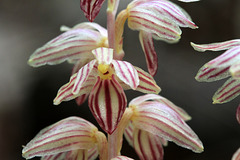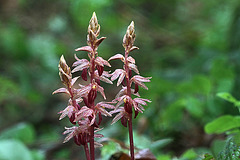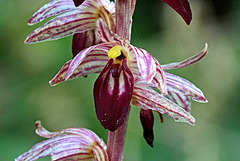RHH's photos with the keyword: striata
Striped Coralroot
| 19 Jul 2019 |
|
|
|
When we hiked in the Columbia River Gorge we were looking for Phantom Orchids but also for these and other Coralroots. The Striped Coralroots were nearly finished but we found a few still blooming.
Blackpoll Warbler
| 20 May 2019 |
|
|
|
I believe this is a female Balckpoll Warbler, but am not certain. It was photographed in Millennium Park in Grand Rapids, Michigan.
Striped Coralroot
| 28 Feb 2018 |
|
|
|
The Coralroots are leafless, achlorophyllous orchids that live, via a fungus, off decaying material in the soil. This, the Striped Coralroot, Corallorhiza striata, is the most beautiful of the species we have here in Washington. The photo was taken during a dry spring, thus the aphids on this plant, as on many of the wildflowers that year.
Striped Coralroot
| 25 Apr 2015 |
|
|
|
This is the third native orchid of the season to be blooming in our area (I don't think I posted the second). It's the Striped Coralroot, Corallorhiza striata var. striata. I was out today and hiked about 13 miles doing some orchid hunting in new areas, but this I found in a location in Larrabee State Park where we had seen this orchid before. The Coralroots are myco-heterotrophic, depending for their food on a complex relationship with a soil fungus. They have no chlorophyll of their own and no leaves, so all one ever find is an erect flower spike, hard to see before the blooms open and almost invisible after the blooms are finished.
Corallorhiza striata var. striata
| 24 Feb 2015 |
|
|
|
This photograph was taken in Lake Padden Park. It shows one of our more beautiful and unusual native orchids. This plant is without chlorophyll and without leaves and is mycotrophic, obtaining its nutrients through a relationship with a soil fungus. We have four species of Coralroots in the state but this has by far the largest and most beautiful flowers.
Corallorhiza striata var. striata
| 07 Feb 2015 |
|
|
|
This photograph was taken in Lake Padden Park. It shows one of our more beautiful and unusual native orchids. This plant is without chlorophyll and without leaves and is mycotrophic, obtaining its nutrients through a relationship with a soil fungus. We have four species of Coralroots in the state but this has by far the largest and most beautiful flowers.
Striped Coralroot
| 10 Jun 2013 |
|
|
|
All the Coralroots are mycotrophic, that is they tap into a fungus on the roots of other plants and use it to obtain their nutrients. They have no need for chlorophyll, therefore, and these are completely without chlorophyll or leaves.
The Striped Coralroot, Corallorhiza striata var. striata, has the largest and showiest of the five Coralroots here in the northwest. These were photographed on Padden Ridge in the Bellingham area and are paler in color than many I have seen.
ronaldhanko-orchidhunter.blogspot.com/2013/05/lake-padden-and-padden-ridge.html
Calanthe sieboldii
| 17 Apr 2010 |
|
|
Also known as Calanthe striata var. sieboldii, this orchid is a terrestrial plant that is native to east Asia. It was photographed at the Northwest Washington Orchid Society show.
Corallorhiza striata var. striata
| 27 Jul 2011 |
|
These were photographed in the Chuckanut mountains south of Bellingham, Washington earlier this spring. The photo was taken by my wife and was one of the better shots of the excursion.
Corallorhiza striata is also known as the striped Corallroot and is one of the prettier species in that genus. It blooms quite early in our area.
nativeorchidsofthepacificnorthwest.blogspot.com/2011/05/c...
Corallorhiza striata var. striata
| 29 May 2012 |
|
This was taken on an afternoon walk in Sehome Hill Arboretum in Bellingham, adjacent to the campus of Western Washington University. It is not an arboretum in the true sense of the word, but a 180 acre park covered with second growth forest and with much of the native flora preserved.
We found two Coralroots on our hike, this, the Striped Coralroot, as well as the Western Spotted Coralroot. This we found in only one location, the other in quite a number of locations along the trails, though if we had had more time I'm sure we could have found more.
Like all Coralroots, these are leafless, without chlorophyll, and live off decaying plant material in the soil (they are mycotropic). This species has another variety with much smaller flowers that is much more rare and not as showy.
nativeorchidsofthepacificnorthwest.blogspot.com/2012/05/t...
Corallorhiza striata var. striata
| 05 Jun 2012 |
|
These Striped Coralroots are finished blooming now except at higher elevations, but are one of our favorite native orchids, and one we always look for when in bloom. They have the largest and most beautiful flowers of all the Coralroots in our area and are also more difficult to find than many of the others.
This photo was taken in Larrabee State Park on the coast and on a rainy day. We found a lot of Striped Coralroots there this year, perhaps due to the late, cold and wet spring. Larrabee is in the Chuckanut Mountains and is a wonderful place both for its wildflowers and for its tide pools.
The Coralroots are mycotropic plants, without leaves (which makes them hard to find when not in bloom) and without chlorophyll, deriving their nourishment from the soil through a relationship with a fungus (funny thing with which to have a relationship, but that's the way it is). Interesting plants!
More photos and text here: nativeorchidsofthepacificnorthwest.blogspot.com/2012/05/s...
Corallorhiza striata
| 19 Feb 2013 |
|
This photo was taken earlier in the year In Larrabee State Park, but not at Clayton Beach. Near the main road through the park, Chuckanut Drive, there is a walking and biking trail, the Interurban Trail, that follows the road for many miles. This photo was taken along that trail at a spot where we go to see these orchids every year.
Corallorhiza striata has the largest and showiest flowers of any of our native Coralroots. It blooms in the spring and is usually found growing in rather sheltered and shady areas. In this particular location it can be found in some large clumps if they survive the dogs and bikes and hikers who use the trail, but usually they do and people who use the trail seem quite careful to use it responsibly.
All the Coralroots are leafless and without chlorophyll. They live in a symbiotic relation with a fungus and through the fungus obtain their nourishment from decaying material in the soil. Washington has five species of Coralroots, maculata, mertensiana, striata, trifida and wisteriana, plus several important varieties of these species.
nativeorchidsofthepacificnorthwest.blogspot.com/2012/05/s...
Striped Coralroot
| 20 Feb 2013 |
|
|
This is the same native orchid species I posted a few days ago, but a close-up of the flowers. The photo was taken on a rainy day in Larrabee State Park along the Interurban Trail.
The Coralroots are mycotrophic plants, without leaves or chlorophyll and depending on a relationship with a fungus for nourishment. This is the showiest of our five species of Coralroots.
nativeorchidsofthepacificnorthwest.blogspot.com/2012/05/s...
Striped Coralroot
| 20 May 2013 |
|
|
This Coralroot has the largest and showiest flowers of any of the Coralroots in our area. It is also much less common than the other Coralroots, but like them all it is leafless and without chlorophyll and is monotrophic, depending for nourishment on a symbiotic relationship with a fungus in the soil.
nativeorchidsofthepacificnorthwest.blogspot.com/2013/05/f...
Jump to top
RSS feed- RHH's latest photos with "striata" - Photos
- ipernity © 2007-2025
- Help & Contact
|
Club news
|
About ipernity
|
History |
ipernity Club & Prices |
Guide of good conduct
Donate | Group guidelines | Privacy policy | Terms of use | Statutes | In memoria -
Facebook
Twitter














